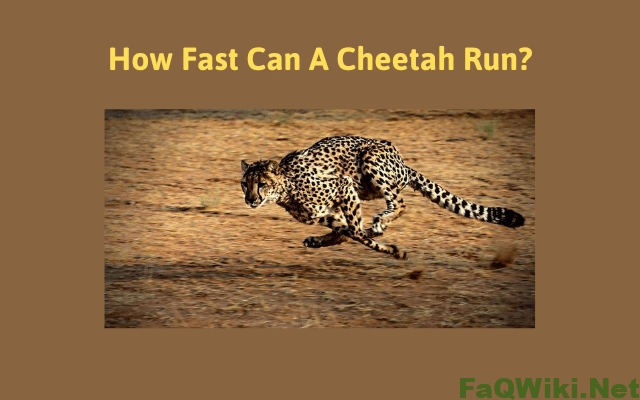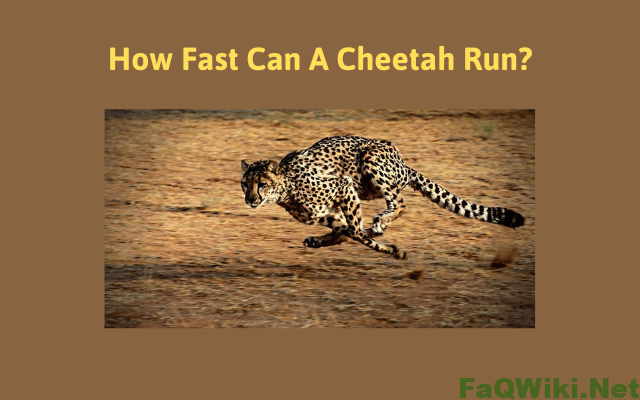How Fast Can A Cheetah Run?

How Fast Can A Cheetah Run? The cheetah is a large, carnivorous cat found primarily in Africa. Known for its incredible speed, the cheetah is one of the most iconic animals on the planet. In this article, we will explore the anatomy of a cheetah, its hunting tactics, and the science behind its incredible speed. We will also discuss the threats facing cheetahs today and what is being done to protect them.

Anatomy of a Cheetah
Cheetahs are built for speed. Their long, slender bodies are covered in sleek fur that helps to reduce air resistance. They have large nostrils and lungs that allow them to take in more oxygen while running, and their hearts pump blood more efficiently than other cats. One of the most unique features of a cheetah is its tail, which is long and flat, acting as a rudder to help with balance and direction changes at high speeds.
Compared to other big cats, cheetahs have longer legs and a more flexible spine, which allows them to take longer strides and turn quickly while running. They also have semi-retractable claws that provide extra traction while running.
The Hunting Tactics of a Cheetah
Cheetahs are built for speed and are known for their incredible hunting abilities. They are capable of reaching speeds of up to 70 miles per hour in short bursts, making them one of the fastest animals on the planet. Their speed is an essential part of their hunting strategy, allowing them to chase down prey and catch it quickly before it can escape.
Cheetahs hunt primarily during the day and focus on prey such as gazelles, impalas, and other small to medium-sized mammals. They use their incredible speed to quickly close the distance between themselves and their prey, often chasing it in a zig-zag pattern to tire it out before making the final sprint to catch it.
The Science of Cheetah Speed
Cheetahs have been studied extensively by scientists, who are interested in understanding the mechanisms behind their incredible speed. One of the key factors contributing to the cheetah’s speed is its unique musculature. Cheetahs have a high proportion of fast-twitch muscle fibers, which allows them to generate more power per stride than other animals.
Another factor is their bone structure, which is designed for maximum efficiency while running. Their long, slender limbs reduce weight and air resistance, and their spines are highly flexible, allowing them to make quick turns while running at high speeds.
Finally, genetics plays a role in cheetah speed. Over millions of years of evolution, cheetahs have developed adaptations that allow them to be the fastest land animal on the planet.
How Fast Can a Cheetah Run?
The top speed of a cheetah is approximately 70 miles per hour, although this can vary depending on a number of factors. Some cheetahs have been recorded running as fast as 75 miles per hour. Speed measurements are typically taken over a short distance, as cheetahs are not able to maintain their top speed for extended periods of time.
Fastest Recorded Cheetahs
The fastest cheetah on record is a female named Sarah, who was clocked running at 61 miles per hour over a distance of 100 meters. Another cheetah named Nyana holds the record for the fastest 200-meter sprint, completing the distance in just 6.19 seconds.
Comparing cheetah speed to other animals and human athletes can be difficult, as different types of speed measurements are used. However, it is generally agreed that cheetahs are the fastest land animals on the planet.
Training and Racing Cheetahs
While it may seem impressive to see a cheetah run at top speed, it’s important to remember that these animals are not meant to be kept in captivity or trained for racing. Cheetahs are wild animals and are best left in their natural habitats. In addition, there are significant ethical concerns surrounding the training and racing of cheetahs.
Threats Facing Cheetahs
Despite their incredible speed and agility, cheetahs are facing a number of threats in the wild. Habitat loss and fragmentation, as well as human-wildlife conflict, are major issues for cheetah populations. In addition, cheetahs are often targeted by poachers for their fur and other body parts, which are used in traditional medicine and for decoration.
Conservation Efforts
Efforts to protect cheetahs are ongoing, with a number of organizations working to conserve and protect cheetah populations in the wild. These efforts include habitat restoration and protection, anti-poaching initiatives, and education and awareness campaigns.
Conclusion
The cheetah is an incredible animal, known for its incredible speed and agility. Its unique anatomy and hunting tactics have been studied by scientists for decades, and efforts to protect cheetah populations are ongoing. While it may be tempting to train and race cheetahs, it’s important to remember that these animals are wild and should be left in their natural habitats.
FAQs
How long can a cheetah maintain its top speed?
Cheetahs are not able to maintain their top speed for extended periods of time. They are typically able to maintain speeds of around 30 to 40 miles per hour for short distances, such as when hunting prey.
Are cheetahs dangerous to humans?
While cheetahs are wild animals and can be unpredictable, they are generally not considered to be a threat to humans. However, it’s important to remember that all wild animals should be treated with respect and caution.
How many cheetahs are left in the wild?
The exact number of cheetahs in the wild is difficult to determine, but estimates suggest that there are around 7,000 to 10,000 individuals remaining in the wild.
